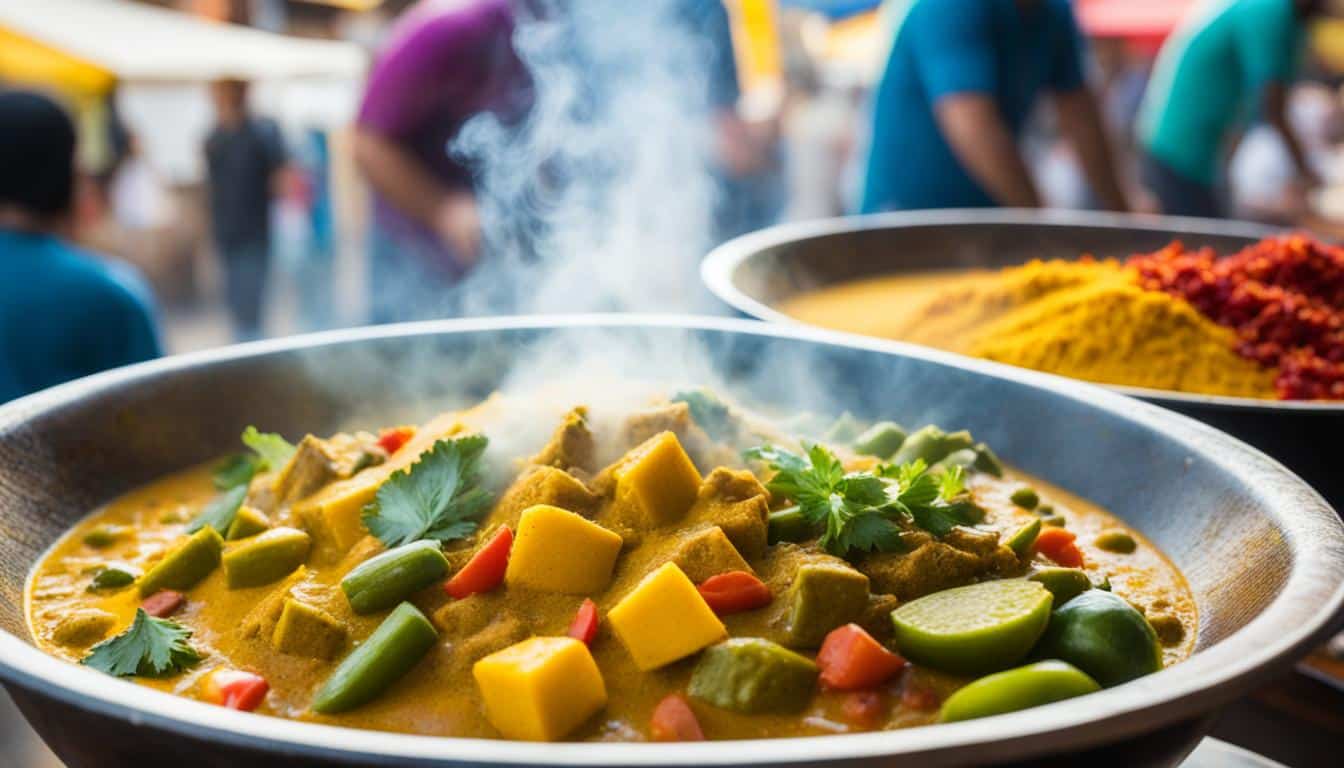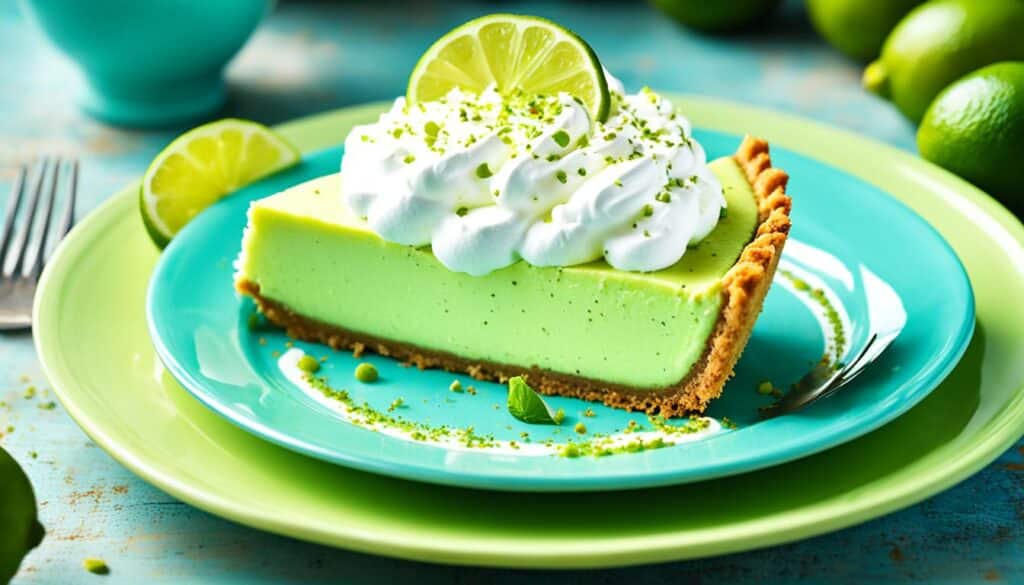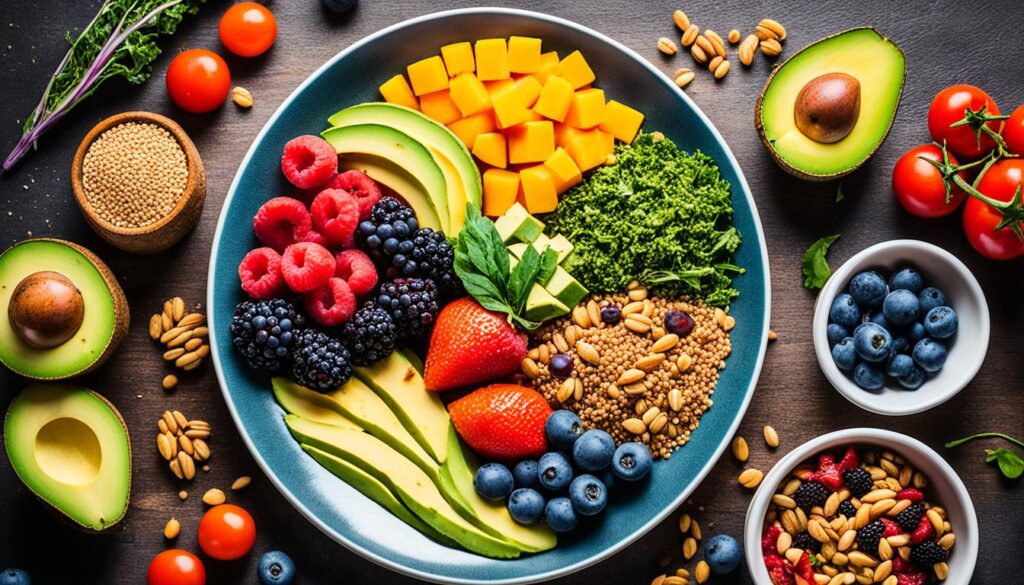Indulge in the flavors and aromas of India with our collection of authentic vegan curry recipes. From creamy coconut chickpea curry to Balinese yellow curry, these recipes will transport you to the heart of culinary delight. Let’s explore the richness of Indian cuisine and learn how to create these flavorful dishes right in your own kitchen.
Key Takeaways:
- Authentic vegan curry recipes bring the true essence of Indian flavors to your plate.
- From creamy coconut chickpea curry to vibrant Balinese yellow curry, there’s a recipe for every curry lover.
- Explore the art of making homemade curry paste for an authentic touch.
- Customize your curry by adding extra vegetables and experimenting with different spices.
- Complete your curry experience with fluffy basmati rice or naan bread as perfect accompaniments.
Creamy Vegan Coconut Chickpea Curry
Looking for the best vegan curry recipe? Look no further than this Creamy Vegan Coconut Chickpea Curry. Made in one pot and packed with flavor, it’s the perfect option for a quick and easy weeknight dinner. With the goodness of chickpeas and the creamy richness of coconut milk, this curry is not only delicious but also a healthy choice.
Whether you’re a vegan or simply looking to incorporate more plant-based meals into your diet, this easy vegan curry will satisfy your cravings and leave you wanting more. Plus, it’s a great recipe for meal prep, so you can enjoy leftovers throughout the week.
What sets this vegan coconut chickpea curry apart is its simplicity. With just a handful of wholesome ingredients, you can create a flavorful and satisfying meal in no time. The combination of tender chickpeas, aromatic spices, and creamy coconut milk creates a harmonious balance of flavors that will delight your taste buds.
Here’s the recipe for this easy vegan curry:
Ingredients:
- 1 can of chickpeas, drained and rinsed
- 1 onion, diced
- 2 cloves of garlic, minced
- 1 tablespoon of curry powder
- 1 teaspoon of cumin
- 1 teaspoon of turmeric
- 1 can of coconut milk
- Salt and pepper to taste
- Fresh cilantro, for garnish
Instructions:
- In a large pot, sauté the diced onions and minced garlic until fragrant.
- Add the curry powder, cumin, and turmeric. Stir to coat the onions and garlic with the spices.
- Add the drained chickpeas and pour in the coconut milk. Season with salt and pepper to taste.
- Simmer the curry on low heat for 15-20 minutes, allowing the flavors to meld together.
- Garnish with fresh cilantro and serve hot with steamed rice or naan bread.
Enjoy the creamy, flavorful goodness of this vegan coconut chickpea curry for a satisfying weeknight dinner that’s easy to make and bursting with authentic flavors. Whether you’re a seasoned vegan or just starting your plant-based journey, this recipe is sure to become a staple in your kitchen.
Balinese Yellow Curry with Coconut Milk and Turmeric
Experience the vibrant flavors of Bali with this authentic Balinese yellow curry. Made with a blend of Balinese herbs and spices, this vegetarian curry is a delicious and aromatic dish that will transport you to the tropical paradise of Indonesia. The combination of creamy coconut milk and turmeric gives the curry a luscious texture and a vibrant yellow color that is as pleasing to the eye as it is to the palate.
To create the rich and aromatic base for this curry, we start by making a Balinese curry paste. This paste is made from a mixture of traditional herbs and spices, including lemongrass, kencur root, and galangal. These ingredients are finely ground together to create a paste that is bursting with flavor.
Once the curry paste is ready, we combine it with coconut milk and turmeric to create the luscious yellow curry sauce. The coconut milk adds a creamy and silky texture to the curry, while the turmeric not only gives it a vibrant color but also adds a subtle earthy flavor. Together, these ingredients create a harmonious blend of flavors that perfectly complement the vegetable medley in the curry.
Ingredients
- 1 cup mixed vegetables (such as broccoli, carrots, and bell peppers)
- 1 cup coconut milk
- 2 tablespoons Balinese curry paste
- 1 teaspoon turmeric powder
- Salt to taste
- Water as needed
Instructions
- In a pan, heat some oil and sauté the vegetables until they are tender.
- Add the Balinese curry paste and turmeric powder to the pan and cook for a few minutes, allowing the flavors to meld together.
- Pour in the coconut milk and stir well to combine.
- Add salt to taste and adjust the consistency of the curry with water if needed.
- Simmer the curry for about 10-15 minutes, allowing the flavors to develop.
- Serve the Balinese yellow curry hot with steamed rice or naan bread.
Enjoy the explosion of flavors in every spoonful of this Balinese yellow curry. The combination of Balinese herbs, coconut milk, and turmeric creates a truly authentic and mouthwatering vegetarian curry that will satisfy your cravings for Indonesian cuisine.
Bring a taste of Bali to your kitchen with this Balinese yellow curry recipe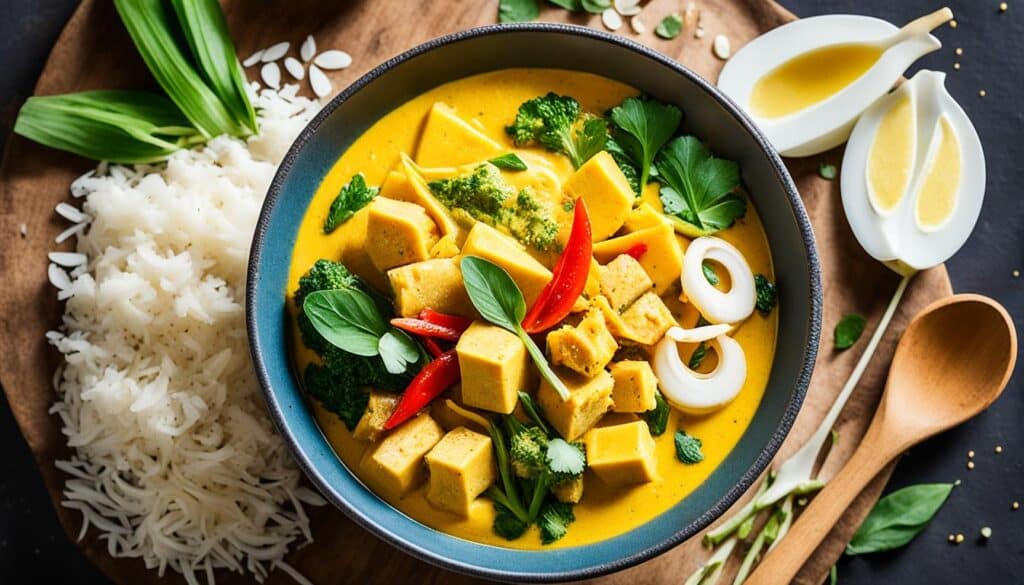
Chana Masala – Indian Chickpea Curry
Chana masala, also known as Indian chickpea curry, is a beloved vegetarian dish that originates from India and Pakistan. This flavorful curry showcases the cultural richness and exquisite flavors of the Indian subcontinent. Made with a combination of chickpeas, onions, tomatoes, and aromatic spices like garam masala, it offers a tantalizing blend of savory and tangy notes. The use of garam masala adds a warm and earthy flavor profile to the dish, enhancing its overall taste.
To create a creamy and rich texture, this recipe incorporates the addition of coconut flour. The coconut flour acts as a natural thickener, giving the curry a luscious consistency. Additionally, this ingredient adds a subtle hint of coconut flavor that perfectly complements the other spices and ingredients in the dish.
One of the key components of chana masala is the robust combination of onions and tomatoes. These ingredients form the foundation of the curry, providing a balanced base of flavors. The onions add a sweet and slightly caramelized taste, while the tomatoes impart a tangy and acidic note. Together, they create a harmonious blend of flavors that make this dish truly authentic.
Chana masala is a protein-packed dish that is both comforting and satisfying. The chickpeas, also known as chana, are a great source of plant-based protein, making this curry a nutritious choice. Whether enjoyed with steamed rice, naan bread, or as a standalone dish, chana masala is a flavorful and wholesome option for vegetarians and curry enthusiasts alike.
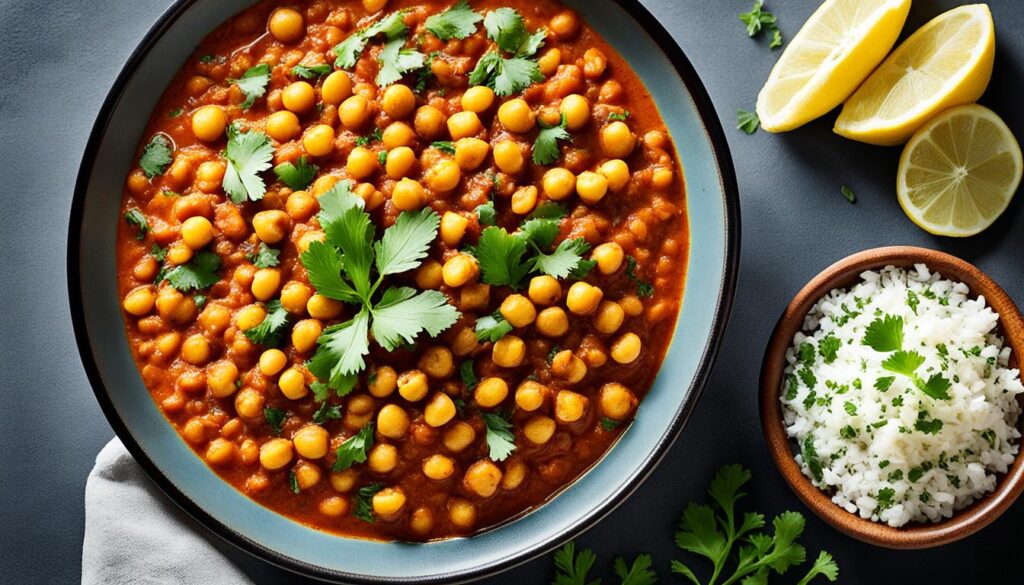
Variations:
- Add diced potatoes for a heartier version of the curry.
- For a spicier kick, incorporate red chili powder or fresh green chilies.
- Experiment with different variations of garam masala to explore unique flavor profiles.
- Garnish the curry with freshly chopped cilantro for added freshness and brightness.
Recipe:
Here’s a simple recipe to create your own Chana Masala:
- In a large pan, heat oil over medium heat. Add chopped onions and sauté until golden brown.
- Add minced garlic and ginger. Cook for 1-2 minutes until fragrant.
- Stir in diced tomatoes, garam masala, turmeric, and ground cumin. Cook for 2-3 minutes, allowing the flavors to meld.
- Add drained and rinsed chickpeas to the pan. Mix well to coat the chickpeas with the spice mixture.
- Pour in coconut milk and coconut flour, stirring gently to combine.
- Reduce the heat to low, cover, and simmer for 15-20 minutes to allow the flavors to develop.
- Season with salt and pepper to taste.
- Garnish with fresh cilantro and serve hot with rice or naan bread.
Enjoy the delightful flavors of chana masala – a dish that captures the essence of Indian cuisine!
How to Make the Perfect Curry Paste
The heart and soul of any curry is the curry paste. It’s what imparts those bold and aromatic flavors that make each curry unique. In this section, we’ll guide you through the process of creating the perfect curry paste with authentic flavors using traditional techniques.
When it comes to curry paste, there are countless variations depending on the cuisine and region. In this article, let’s focus on the exquisite flavors of Balinese curry paste. This unique blend combines a harmonious mix of Balinese herbs and spices, creating a paste that will elevate your curry to new heights.
Gather the Authentic Ingredients
To make Balinese curry paste, you’ll need a handful of traditional spices and herbs. Here’s a list of the essential ingredients:
- Kencur root
- Galangal
- Lemongrass
- Shallots
- Garlic
- Candlenuts
- Turmeric
- Coriander seeds
- Balinese long red chilies
These ingredients can be found at specialty Asian markets or ordered online. The combination of these flavors creates a vibrant and aromatic base for your curry.
The Art of Grinding
Once you have all the ingredients ready, it’s time to grind them into a paste. Traditionally, a mortar and pestle are used for this purpose, allowing you to create a texture that balances smoothness with a slight graininess. The grinding process helps extract the fullest flavor from the spices and herbs.
Tip: For an even stronger flavor, toast the coriander seeds in a dry pan before adding them to the mortar.
Begin by peeling and chopping the shallots, garlic, kencur root, and galangal into small pieces. Then, remove the tough outer layers of the lemongrass and finely chop the tender inner stalks. Next, remove the seeds and stems from the Balinese long red chilies.
Add the prepared ingredients to the mortar one by one, grinding each until it forms a homogeneous paste. Start with the harder ingredients like galangal and kencur root and gradually add the rest. Take your time and exert gentle pressure while grinding to release the flavors.
The result should be a vibrant and aromatic curry paste that captures the true essence of Balinese cuisine.
Intensify the Flavors
If you prefer a spicier curry paste, you can adjust the heat by adding more Balinese long red chilies. For a milder flavor, reduce the quantity of chilies or remove the seeds before grinding. Remember, the beauty of making your own curry paste is that you have full control over the intensity of the flavors.
Preservation and Usage
To store your homemade curry paste, transfer it to an airtight container and refrigerate. It will stay fresh for up to a week, allowing you to use it whenever you’re ready to cook a curry. Additionally, you can freeze the curry paste in smaller portions to extend its shelf life.
Now that you have mastered the art of making the perfect curry paste, it’s time to explore the endless possibilities of creating delicious and authentic curries right in your own kitchen.
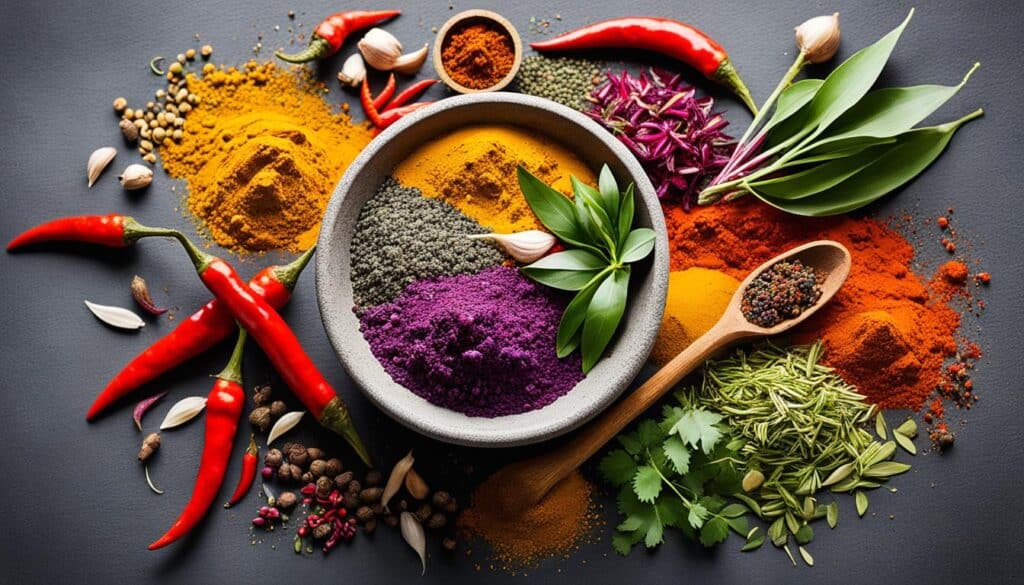
Make your curries burst with authentic flavor using homemade curry paste made with traditional techniques and a blend of Balinese herbs and spices.
Tips for Perfecting Your Curry
Take your curry game to the next level with these tips and tricks. With a few simple adjustments, you can transform your curry into a culinary masterpiece. Here are some expert tips to help you perfect your curry:
- Enhance the flavors of your curry by adding a splash of lime juice. The tangy acidity of lime juice brightens up the dish and brings out the complex flavors of the spices.
- Experiment with curry variations to find your favorite flavor profile. From spicy and bold to mild and aromatic, there is a wide range of curry pastes and powders available to suit every taste.
- Opt for light coconut milk if you prefer a lighter and less creamy curry. This option reduces the richness of the dish while still providing a subtle coconut flavor.
- Add extra vegetables to your curry to amp up the nutritional value and add a delightful crunch. Sweet potatoes, bell peppers, and spinach are excellent choices that complement the flavors of the curry.
By following these tips, you can customize your curry to suit your preferences and create a truly unique dish. Let your creativity shine and experiment with different combinations of flavors and ingredients to take your curry to new heights.
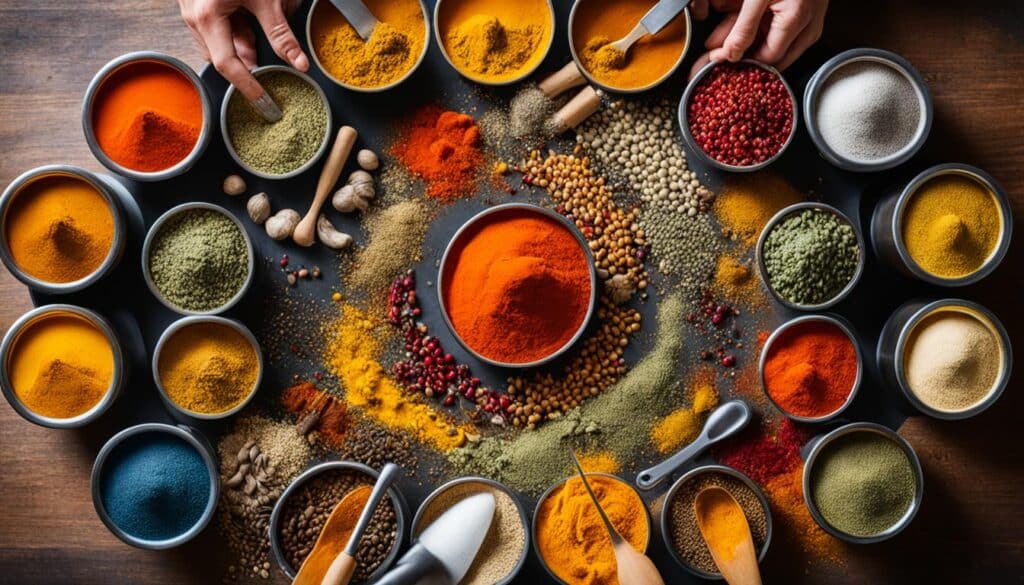
Curry Variations
Curry is a versatile dish that can be customized in various ways. Here are some popular curry variations:
| Curry Variation | Main Ingredients | Flavor Profile |
|---|---|---|
| Thai Green Curry | Green curry paste, coconut milk, vegetables, tofu or chicken | Spicy, fragrant, with hints of basil and lemongrass |
| Indian Butter Chicken | Chicken, tomato sauce, butter, cream, spices | Rich, creamy, and mildly spiced |
| Japanese Curry | Golden curry roux, vegetables, meat or tofu | Mild, thick, and slightly sweet |
| Indonesian Rendang | Beef, coconut milk, spices, toasted coconut | Rich, aromatic, and intensely flavorful |
Benefits of Adding Extra Vegetables
Adding extra vegetables to your curry not only enhances its nutritional value but also adds depth of flavor and texture. Here are a few reasons why you should consider adding more vegetables:
- Nutritional boost: Vegetables such as sweet potatoes and bell peppers are packed with essential vitamins, minerals, and dietary fiber.
- Texture and color: Vegetables add variety and visual appeal to your curry, making it more enticing.
- Balance and freshness: The natural sweetness and crunch of vegetables balance the spiciness of the curry, creating a well-rounded flavor profile.
“Adding extra vegetables to curry is a great way to incorporate more plant-based goodness into your diet while elevating the overall taste and texture of the dish.” – Chef Emily Thompson
With these tips and tricks, you can take your curry from ordinary to extraordinary. Whether you’re an experienced cook or a beginner in the kitchen, experimenting with different flavors and techniques will help you create a curry that is truly delicious and satisfying.
Serving Suggestions for Your Curry
Complete your curry experience with the perfect accompaniments. Serve your curry with fluffy basmati rice or naan bread to soak up the delicious sauce. Add extra vegetables like carrots, sweet potatoes, or bell peppers for added crunch and nutrition. The options are endless, so get creative and enjoy your curry with a variety of sides.
Enhance the Flavors with the Perfect Curry Accompaniments
- Rice: Serve your curry with a side of fluffy basmati rice. The light and fragrant rice will complement the rich flavors of the curry.
- Naan Bread: Indulge in some freshly baked naan bread to mop up every last drop of the delicious curry sauce. The soft and chewy naan provides a perfect contrast to the creamy curry.
- Vegetables: Add extra vegetables to your curry to boost its nutritional value and add a pop of color to your meal. Carrots, sweet potatoes, and bell peppers are popular choices that provide a delightful crunch.
Experiment with different combinations and flavors to find your preferred curry accompaniments. Whether you prefer a simple plate of rice or a hearty serving of naan bread and vegetables, these side dishes will elevate your curry to new heights.
Storing and Freezing Curry
Don’t let your leftover curry go to waste. Properly storing and freezing curry allows you to enjoy its delicious flavors even days or weeks later. Follow these tips to maximize the shelf life of your curry:
Storing Curry
When storing curry in the refrigerator, it’s important to use an airtight container to prevent odors from seeping in and to maintain freshness. Here’s how:
- Allow the curry to cool down to room temperature before storing.
- Transfer the curry to an airtight container, ensuring there is enough space to accommodate the entire portion.
- Seal the container tightly to prevent air and moisture from getting in.
- Label the container with the date of preparation to keep track of its freshness.
- Place the container in the refrigerator and store for up to 4 days.
Freezing Curry
If you have a surplus of curry or want to save some for later, freezing is a convenient option. Follow these steps to freeze curry:
- Divide the curry into single-serving portions for easy thawing and reheating.
- Allow the curry to cool down completely before freezing.
- Transfer each portion into separate airtight containers or freezer bags.
- Seal the containers or bags tightly to prevent freezer burn and maintain quality.
- Label each container or bag with the date and contents.
- Place the containers or bags in the freezer and store for up to 3 months.
Pro tip: Thaw one-person lunches or dinners throughout the week for a quick and easy meal. Simply transfer the frozen curry to the refrigerator overnight and reheat as desired.
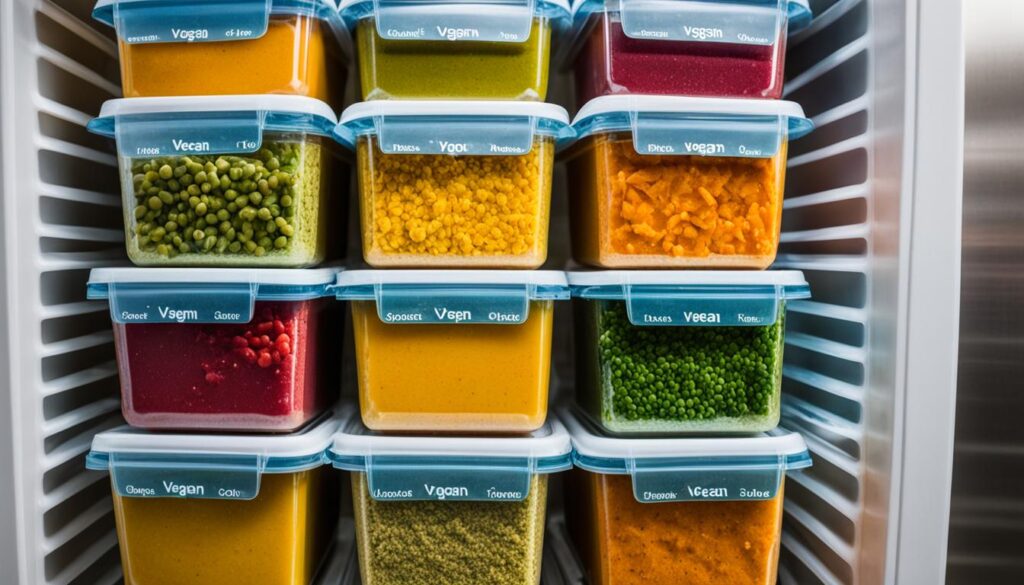
Now you can enjoy the flavors of your favorite curry recipes even when you have leftovers. By storing curry correctly in the refrigerator or freezer, you can extend its shelf life and ensure that it remains delicious and ready for future meals.
Conclusion
Creating delicious and authentic vegan curry recipes is easier than you think. With the right ingredients and techniques, you can recreate the flavors and aromas of traditional Indian and Balinese curries in your own kitchen. Whether you’re craving a creamy coconut chickpea curry or a vibrant Balinese yellow curry, these recipes will delight your taste buds and transport you to exotic destinations. Enjoy the rich flavors and wholesome ingredients of these authentic vegan curry recipes.
Indulge in the aromatic spices and vibrant colors that make these vegan curry recipes a true culinary delight. These dishes are not just about nourishing your body, but also about experiencing the cultural heritage and gastronomic traditions of these regions. From the creamy coconut milk in a Balinese yellow curry to the rich flavors of garam masala in an Indian chickpea curry, each recipe offers a unique taste that will leave you craving for more.
Delight your senses with these authentic vegan curry recipes, where each bite is a journey to a land of authentic flavors and culinary excellence.
Take Your Taste Buds on a Journey
Exploring the diverse world of vegan curry recipes allows you to experience the authentic flavors that have been perfected over generations. By following these recipes, you can embark on a culinary adventure that takes you from the bustling streets of Kolkata to the tranquil beaches of Bali.
Delve into the creamy richness of a coconut chickpea curry, where the earthy chickpeas are bathed in a luxurious blend of spices and coconut milk. Let the warmth and depth of flavors transport you to the vibrant markets of Southern India.
Or, savor a vibrant Balinese yellow curry, where the fragrant turmeric and aromatic spices come together with coconut milk for a burst of flavors. Close your eyes, and you can almost feel the gentle sea breeze and taste the tantalizing street food of Bali.
Embrace Your Inner Chef
With these authentic vegan curry recipes at your fingertips, you have the power to create culinary masterpieces in your own kitchen. Make them your own by experimenting with additional spices, herbs, or vegetables to suit your taste.
Don’t be afraid to unleash your creativity and adapt these recipes to your preferences. Add a touch of tanginess with a squeeze of lime juice or elevate the creaminess with extra coconut milk. The possibilities are endless, and each variation will bring a unique twist to your vegan curry.
Savor the Authentic Flavors
As you indulge in the authentic flavors of these vegan curry recipes, you’ll realize that culinary delight goes hand in hand with wholesome and nutritious ingredients. From the hearty chickpeas packed with fiber and protein, to the vibrant array of spices that offer a myriad of health benefits, these curries are as good for your body as they are for your taste buds.
So gather your ingredients, sharpen your knives, and create a sensory experience that will transport you to far-off lands with just one bite. Discover the true essence of vegan curry recipes and relish in the delightful fusion of flavors that will leave you craving for more.
Also Read:-
Your Guide To The Best Healthy Cat Food For Feline Wellness
Conclusion
In conclusion, if you’re looking to explore the rich flavors of Indian and Balinese cuisine, authentic vegan curry recipes are the way to go. These recipes not only offer a delicious and satisfying culinary experience but also provide a range of flavors and textures that will elevate your weeknight dinners.
Whether you’re craving the creamy goodness of a coconut chickpea curry or the vibrant hues of a Balinese yellow curry, these recipes are sure to delight your taste buds. With the right combination of ingredients and techniques, you can recreate the authentic flavors of these curries in the comfort of your own kitchen.
So, why not indulge in the culinary delight of authentic vegan curry recipes? Get cooking and savor the aromatic spices, wholesome ingredients, and mouth-watering flavors that these dishes have to offer. Your taste buds will thank you!
FAQs
-
Q: What is the key feature of the vegan curry recipes in this collection?
A: The vegan curry recipes in this collection focus on authentic Indian flavors and ingredients, providing a true essence of traditional Indian cuisine.
Q: Are there any cauliflower-based curry recipes included in this selection?
A: Yes, there are delicious cauliflower curry recipes featured in this collection that showcase the versatility of this vegetable in vegan cooking.
Q: How would you describe the level of difficulty for the easy vegan curry recipes?
A: The easy vegan curry recipes included here are designed to be simple and straightforward, perfect for a quick and hassle-free weeknight dinner indian recipes.
Q: Do the recipes incorporate creamy coconut milk for a rich and indulgent flavor?
A: Yes, many of the vegan curry recipes in this collection use creamy coconut milk to create a luscious and comforting texture in the dishes recipe card.
Q: Can I find Indian-inspired spinach curry recipes in this selection?
A: Absolutely! You will find a variety of Indian-inspired spinach curry recipes that highlight the vibrant flavors of this leafy green vegetable add the garlic.
Q: Are there options for those looking to make authentic vegan Indian curries at home?
A: Yes, the collection includes recipes that help you recreate the authentic flavors of Indian curries using plant-based ingredients and traditional spices make this recipe.
Q: Are there any specific tips on how to best enjoy the vegan curry recipes in this collection?
A: To fully savor the flavors, it’s recommended to pair the vegan curries with vegan naan or rice for a complete and satisfying meal experience.
Q: Do the recipes cater to a variety of tastes, including those who prefer spicy curries?
A: Yes, there are options for those who enjoy spicy curries, with recipes that feature a range of warming Indian spices to add heat and depth to the dishes.
